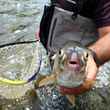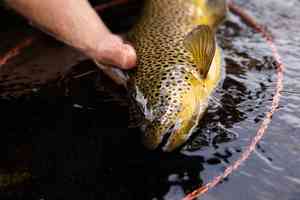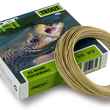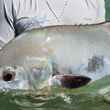I probably shouldn’t admit this, but leaders and tippets confused the heck out of me when I first started fly fishing. After all, if you were a spin fisherman, as I was back in the mid 80s, your terminal end tended to be pretty basic. You either tied your lure directly to your line, or, if you wanted to get fancy, you used a snap swivel to add flexibility to your rig. By comparison, fly fishing was rocket science. Not only did you have to understand the complicated terminology, but you were supposed to construct your leaders from scratch, using archaic formulas developed by physics professors masquerading as anglers.
For example, in A. J. McClane’s The Practical Fly Fisherman, there were 9 different tapered leader formulas on page 72. The very first was: 40” of .018, 36” of .017, 7” of .016, 7” of .014, 7” of .013, 7” of .012, and 28” of .010.
In this formula, the .018s, etc., refer to the diameter of the material, while the 40”s, etc., give the length of the individual sections. Then, of course, there’s the question of whether to use hard nylon, soft nylon or both; or whether you should go old school and build your leaders from gut (or bat wing, or eye of newt). Heck, even if you knew how to handle a fly rod and tie a blood knot, leader construction was daunting.
So let’s try to simplify things by starting out with a few basics. When I refer to a “leader,” I’m talking about a length of material (or materials) that connects your fly line to your fly. Some leaders are tapered, others are level. Some are one piece, others are created by knotting together a number of shorter sections. Some are solid, others are braided or furled. But they’re all leaders, and their object is simple - to connect your fly to your fly line in a way that helps you catch fish.
“Tippet material,” also often referred to simply as "tippet," comes on spools, and it’s the stuff we use to build leaders from scratch, or to repair or adjust the one we’re using at the moment. Tippet material is measured in Xs, as in 3X, 4X, 5X, etc, or in pounds breaking strength. Most store-bought leaders also come with X designations. For tapered leaders, the X tells you the diameter of the narrowest part of the leader.
The term “the tippet” is also commonly used to refer to very end of the leader, the part that attaches to the fly.
Please keep in mind that Xs correspond to diameter, not breaking strength. For example, every manufacturer’s 5X material is supposed to be .006” in diameter, while every 3X is supposed to be .008” in diameter. This has a couple ramifications. The first is that 3X is thicker (and has greater strength) than 4X, which is in turn thicker and stronger than 5X. A simple rule of thumb is the higher the number, the thinner the diameter.
At the same time, 4X material from Company A may well have a different breaking strength than 4X material from Company B. Just because the diameter is the same doesn’t mean that the strength is equal. After all, different companies use different chemical formulations when they create their leaders and tippets, and their products have different characteristics.
So how does all this translate to the trout stream? Well, if you’re fishing dry flies on the surface or dead drifting nymphs below a floating line, you’ll want to use a relatively long, tapered leader. For big fish, big flies or fast, choppy water, you’ll go heavier, somewhere in the 3X to 4X range. For smaller flies or smoother water, 5X or 6X is probably more appropriate.
If you’re fishing streamers, nymphs or wets with a sink-tip or a full sinking line, you’ll need a shorter, stouter leader. How short and how stout? Well, that depends on the size of the fly, the clarity of the water, and the size of the fish that you’re after. To give you a general idea, many anglers prefer 9’, 5X leaders for floating lines, but they’ll drop down to 6’, 2x leaders (or even a 4’ hunk of 0X tippet material) for sinking lines. But please keep in mind that these are only general guidelines, and that there are any number of exceptions you’ll run across on the water.

So what brands should you use?
Well, first off, pick something you’re comfortable with. My favorites are TroutHunter, Umpqua, Orvis, and Climax. Then decide on the type of material you want. If I’m going to fish streamers, wets or nymphs, I like fluorocarbon leaders and tippets. The TroutHunter Fluorocarbon, Orvis Mirage and the Umpqua SuperFluoro are all superb. They offer improved knot strength, excellent abrasion resistance and they practically disappear in the water, allowing you to hook finicky fish on heavier tippets. All three will give you a decided advantage over traditional nylon, especially if you’re fishing for leader-shy fish like Great Lakes steelhead or spring creek trout.
The only major problem with the newer fluorocarbon material is that, unlike nylon, it won’t break down out and disintegrate in nature. Consequently, you want to make sure you collect all your clipping and worn-out leaders and dispose of them in the trash.
If I’m going to fish dry flies, I still use old-fashioned nylon, as it doesn’t sink like the fluorocarbon and I don’t have to be quite as fussy with my knots. TroutHunter Evo Nylon, Orvis Super Strong and Umpqua are all superb choices, and if you don’t already have a preference, I’d recommend each of them without hesitation.
Now this next statement might surprise you, but I don’t carry a whole bunch of leaders in various sizes. Rather, I’ll throw a handful of 9’, 4X and 7 1/2’, 3X tapered leaders in my vest, along with spools of tippet material ranging from 0X all the way down to 7X. With a little judicious clipping, or with a few additional pieces of tippet, I can fashion anything from a 13’, 6X dry fly leader I’d use on the Henry’s Fork to a 4’, 0X leader that would be perfect for steelhead or salmon on a sinking line.
Of course, if you don’t want to customize your leaders, there’s no rule that says you need to. There’s such a wide variety available today, and they’re so easy to use, that even a rank novice can fish right off the shelf.
So that’s the story on leader and tippets. I do want to add one word of caution, though. Some manufacturer’s material will work well with different brands, others won’t. If you want to avoid frustration while you experiment with various combinations, find a brand you like and stick with it. Trust me. You’ll be a lot happier in the long run.































Comments
Paul replied on Permalink
It is too bad manufacturers cannot make something that eventually breaks down in nature. In the long run it may be more important go easy on the environment than to catch that one extra fish.
Jay replied on Permalink
A nice little piece of information that some folks find helpful is knowing what size fly to use with what diameter tippet. A nice "ballpark rule" is the divide by 4 rule. As in, if you are fishing a size 16 BWO, divide by 4 = 4 or 4x tippet. This gets you in the ballpark. You can always scale down for wary fish to a 5x. Same would apply for larger flies. A size 4 clouser, you would use a 1x. Thanks for sharing this article - great explanation of a sometimes confusing subject.
Jere Crosby replied on Permalink
What do you consider adequate breakdown on a constructed leader today given graphite material rods?
I only breakdown from a butt section to two more reduced size sections to a tippet ring, and then add a tippet to my tippet ring for constructing a 9-10' tapered leader to a dry line. For a sinking line I use one twisted butt section to a small swivel in the end loop, and then the tippet section to prevent larger fish from twisting the hook.
Pages